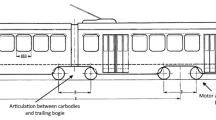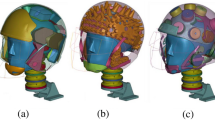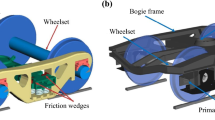Abstract
This paper is devoted to the design and first implementation of a new head and neck safety device (NHNS) for race of motorcycles. The system aims to mitigate the effects of crash forces acting along almost every direction with respect to the head. The system is composed by a helmet, linked to a jacket by means of a number of cables and a by a number of stop surfaces to limit both the flexion and extension of the neck. Stop surfaces are provided also to limit the lateral leaning of the head. Preliminary numerical simulations, performed by a simplified human model, and experimental tests, ran by using a Hybrid III dummy, show that the NHNS has the potential to actually reduce the neck damage in some relevant crash situations. The effect of the device is reducing the load acting on the passenger’s neck and maintaining the vertebrae rotations within the physiological limits.
Similar content being viewed by others
Abbreviations
- a:
-
acceleration, m/s2
- F:
-
force, N
- M:
-
moment, Nm
- t:
-
time, s
- v:
-
velocity, m/s
- δ:
-
deformation, m
- int:
-
critical internal (force or moment)
- rel:
-
relative
- x:
-
longitudinal direction
- y:
-
lateral direction
- z:
-
sagittal (vertical) direction
References
ACIS CENSIS (2006). VIII Rapporto Due Ruote ACI CENSIS 2006.
Ballo, F., Gobbi, M., Mastinu, G. and Previati, G. (2016). A six axis load cell for the analysis of the dynamic impact response of a hybrid III dummy. Measurement, 90, 309–317.
Bigi, D., Heilig, A., Steffan, H. and Eichberger, A. (1998). A comparison study of active head restraints for neck protection in rear end collisions. Proc. 16th Int. Technical Conf. Enhanced Safety of Vehicles (ESV), Windsor, Canada.
Bohman, K., Bostrom, O. H., Land, Y. and Kullgren, A. (2000). A study of AIS1 neck injury parameters in 168 frontal collisions using a restraint hybrid III dummy. Stapp Car Crash Journal, 44, 103–116.
British Standars Institution (1985). BS 6658, Specification for Protective Helmets for Vehicle Users.
Chinn, B., Bertrand, C., Siegfried, D., Doyle, D., Dietmar, O., Schuller, E. and Willinger, R. (2001). COST 327 Motorcycle Safety Helmets. Office for the Publication of the European Communities, Luxemburg.
Economic Commission for Europe (2002). ECE Regulation 22: Protective Helmets and Their Visors for Drivers and Passengers of Motor Cycles and Mopeds.
Eppinger, R., Sun, E., Bandak, F., Haffner, M., Khaewpong, N., Maltese, M., Kuppa, S., Nguyen, T., Takhounts, E., Tannous, R., Zhang, A. and Saul, R. (1999). Development of Improved Injury Criteria for the Assessment of Advanced Automotive Restraint Systems - II. NHTSA Report.
European Commission (2015). Transport in Figures 2015. DOI: https://doi.org/10.2832/861735.
FIA (2002). Norme FIA 8858-2002. FIA STANDARD 8858-2002.
FMVSS (2003). Federal Motor Vehicle Safety Standards, Standard No. 218 Motorcycle Helmets.
FMVSS (2012). Federal Motor Vehicle Safety Standards, Standard No. 49 CFR 571.208, Occupant Car Protection.
Galmarini, G., Massimiliano, G., Gianpiero, M. and Giorgio, P. (2013). A method for the assessment of the dynamic performance of neck protection devices. Proc. ASME 15th Int. Conf. Advanced Vehicle Technologies; ASME Int. Design Engineering Technical Conf. and Computers and Information in Engineering Conf., 1–12.
Geigl, B. C., Steffan, H., Leinzinger, P., Roll, P., Mühlbauer, M. and Bauer, G. (1994). The movement of head and cervical spine during rearend impact. IRCOBI Conf. Proc., 127–138.
Gobbi, M., Mastinu, G., Previati, G. and Tarallo, E. (2012). Dynamic performance of neck protection devices: Performance analysis based on a simplified multibody model of the human neck. Proc. ASME Design Engineering Technical Conf., 661–669.
Gobbi, M., Previati, G., Guarneri, P. and Mastinu, G. (2011). A new six-axis load cell. Part II: Error analysis, construction and experimental assessment of performances. Experimental Mechanics 51, 3, 389–399.
Gobbi, M., Previati, G. and Mastinu, G. (2015). Neck Protection Device. WO2015136391 A1.
Goldsmith, W. and Ommaya, A. (1984). Head and neck injury criteria and tolerance levels. In Aldman, B. and Chapon, A. (eds) The Biomechanics of Impact Trauma. Elsevier. Amsterdam, The Netherlands, 149–187.
Huang, B. and Preston, J. (2004). A Literature Review on Motorcycle Collisions: Final Report. Oxford University, Transport Studies Unit.
Hubbard, R. P. (2000). Head and Neck Support for Racing. US 6009566 A.
Huston, R. (2008). Principles of Biomechanics. CRC Press. Boca Raton, Florida, USA.
Iijima, S., Hosono, S., Ota, A. and Yamamoto, T. (1998). Exploratory study of an airbag concept for a large touring motorcycle. Proc. 16th Int. Technical Conf. Enhanced Safety of Vehicles, 2260–2278.
ISO 13232-1 (2005). International Standard, Motorcycles — Test and Analysis Procedures for Research Evaluation of Rider Crash Protective Devices Fitted to Motorcycles.
Istat (2011). Incidenti Stradali. https://www.istat.it/it/files//2011/11/incidenti-stradali.pdf
Kullgren, A., Eriksson, L., Bostrom, O. and Krafft, M. (2003). Validation of neck injury criteria using reconstructed real-life rear-end crashes with recorded crash pulses. Proc. 18th ESV Conf., 1–13.
Lankarani, H. M. (1993). Biodynamics Response for the Evaluation of Aircraft Crash Safety. National Institute for Aviation Research. FAA Technical Center. Technical Report.
Leatt, C. J. (2005). Neck Brace. WO 2005051251 A2.
Linder, A., Schmitt, K.-U., Walz, F. H. and Ono, K. (2000). Neck modelling for rear-end impact simulations: A comparison between a multi body system (MBS) and a finite element (FE) model. Proc. Int. IRCOBI Conf. Biomechanics of Impact, Montpellier, France.
Marar, B. C. (1974). Hyperextension injuries of the cervical spine: The pathogenesis of damage to the spinal cord. J. Bone & Joint Surgery 56, 8, 1655–1662.
Mastinu, G., Gobbi, M. and Previati, G. (2011). A new sixaxis load cell. Part I: Design. Experimental Mechanics 51, 3, 373–388.
Mazzarolo, G. and Ballantyne, C. (2012). Adjustable Neck Protective Collar in Particular for Motorcycle Riders. US8291521 B2.
McConnell, W. E., Howard, R. P., Guzman, H. M., Bomar, J. B., Raddin, J. H., Benedict, J. V., Smith, H. L. and Hatsell, C. P. (1993). Analysis of human test subject kinematic responses to low velocity rear end impacts. SAE Paper No. 930889.
Mertz, H. J. and Patrick, L. M. (1967). Investigation of the kinematics and kinetics of whiplash. Proc. 11th Stapp Car Crash Conf., 175–206.
Mertz, H. J. and Patrick, L. M. (1971). Strength and response of the human neck. SAE Paper No. 710855.
Muser, M. H., Walz, F. H. and Schmitt, K.-U. (2002). Injury criteria applied to seat comparison tests. Traffic Injury Prevention 3, 3, 224–232.
Nightingale, R. W., McElhaney, J. H., Camacho, D. L., Kleinberger, M., Winkelstein, B. A. and Myers, B. S. (1997). The dynamic responses of the cervical spine: Buckling, end conditions, and tolerance in compressive impacts. SAE Paper No. 973344.
Nusholtz, G. S., Di Domenico, L., Shi, Y. and Eagle, P. (2003). Studies of neck injury criteria based on existing biomechanical test data. Accident Analysis and Prevention 35, 5, 777–786.
Ono, K. and Kaneoka, K. (1999). Motion analysis of human cervical vertebrae during low-speed rear impacts by the simulated sled. J. Crash Prevention and Injury Control 1, 2, 87–99.
Prasad, P. and Daniel, R. P. (1984). A biomechanical analysis of head, neck, and torso injuries to child surrogates due to sudden torso acceleration. SAE Paper No. 841656.
Previati, G., Gobbi, M. and Mastinu, G. (2017). Silicone gels — Comparison by derivation of material model parameters. Polymer Testing, 58, 270–279.
SAE J1460-2 (2008). Human Mechanical Impact Response Characteristics — Response of the Human Neck to Inertial Loading by the Head for Automotive Seated Postures. Technical Standard.
Schmitt, K.-U., Muser, M. H., Walz, F. and Niederer, P. (2002). N km — A proposal for a neck protection criterion for low speed rear-end impacts. Traffic Injury Prevention 3, 2, 117–126.
Schmitt, K.-U., Niederer, P. F., Muser, M. H. and Walz, F. (2010). Trauma Biomechanics. Springer. Berlin, Germany.
Shankar, U. and States, U. (2001). Fatal Single Vehicle Motorcycle Crashes. U.S. Department of Transportation. National Highway Traffic Safety Administration.
Silva, M., Ambrosio, J. and Pereira, M. (1997). Biomechanical model with joint resistance for impact simulation. Multibody System Dynamics 1, 1, 65–84.
Svensson, M. Y. (1993). Neck Injuries in Rear-end Car Collisions-sites and Biomechanical Causes of the Injuries, Test Methods and Preventive Measures. Technical Report. Chalmers University of Technology.
Svensson, M. Y., Boström, O., Davidsson, J., Hansson, H. A., Håland, Y., Lövsund, P., Suneson, A. and Säljö, A. (2000). Neck injuries in car collisions — A review covering a possible injury mechanism and the development of a new rear-impact dummy. Accident Analysis and Prevention 32, 2, 167–175.
Szabo, T. J., Voss, D. P. and Welcher, J. B. (2003). Influence of seat foam and geometrical properties on BioRID P3 kinematic response to rear impacts. Traffic Injury Prevention 4, 4, 315–323.
Tarallo, E., Gobbi, M., Mastinu, G. and Previati, G. (2011). Evaluation of the dynamic response of the human neck: State of the art review and considerations on restraint systems applications. EUROMECH 511 Colloquium. Ponta Delgada, Portugal.
Willinger, R., Baumgartner, D. and Guimberteau, T. (2000). Dynamic characterization of motorcycle helmets: Modelling and coupling with the human head. J. Sound and Vibration 235, 4, 611–625.
Author information
Authors and Affiliations
Corresponding author
Rights and permissions
About this article
Cite this article
Gobbi, M., Mastinu, G. & Previati, G. Motorcycle Accidents — A New Head and Neck Safety Device for Riders. Int.J Automot. Technol. 20, 25–36 (2019). https://doi.org/10.1007/s12239-019-0003-1
Received:
Revised:
Accepted:
Published:
Issue Date:
DOI: https://doi.org/10.1007/s12239-019-0003-1




